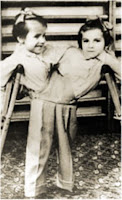[excerpt:]
Conjoined twins are categorized using the suffix "-pagus" from the Greek word for "fixed". Early teratologists such as Ambroise Pare and Geoffrey St. Hillaire were among the first to identify the various types of conjoined twins. Many twins do not fit perfectly into any of these classifications, and the terms are often combined.
 Thoracopagus (left). Joined at the upper chest, from the clavicle to the sternum, each with their own separate heads, arms and legs. The heart is always involved in the conjoinment. In a very few cases, twins sharing a heart have survived for several years. Ruthie and Verena Cady of Rhode Island lived to the age of 7 and were healthy, active girls who rode a tricycle, swam, did gymnastics and went to school. Thoracopagus twins are the most common type, accounting for around 35% of all cases.
Thoracopagus (left). Joined at the upper chest, from the clavicle to the sternum, each with their own separate heads, arms and legs. The heart is always involved in the conjoinment. In a very few cases, twins sharing a heart have survived for several years. Ruthie and Verena Cady of Rhode Island lived to the age of 7 and were healthy, active girls who rode a tricycle, swam, did gymnastics and went to school. Thoracopagus twins are the most common type, accounting for around 35% of all cases.
 Omphalopagus (right). Joined at the abdomen, from the sternum to the groin and often sharing a liver and portions of the digestive system. These twins have separate hearts, heads, arms and legs. Ronnie and Donnie Galyon, born in 1951, are the only non-separated omphalopagus twins in the world today. About 30% of cases.
Omphalopagus (right). Joined at the abdomen, from the sternum to the groin and often sharing a liver and portions of the digestive system. These twins have separate hearts, heads, arms and legs. Ronnie and Donnie Galyon, born in 1951, are the only non-separated omphalopagus twins in the world today. About 30% of cases.
 Xiphopagus (left). Joined at the xiphoid process (part of the sternum) and usually linked only by cartilage and soft tissue. These twins share no vital organs but often have conjoined livers. They are by far the easiest to separate. Chang and Eng Bunker (1811-1874) were xiphopagus twins with conjoined livers. Also called sternopagus. About 3% of cases.
Xiphopagus (left). Joined at the xiphoid process (part of the sternum) and usually linked only by cartilage and soft tissue. These twins share no vital organs but often have conjoined livers. They are by far the easiest to separate. Chang and Eng Bunker (1811-1874) were xiphopagus twins with conjoined livers. Also called sternopagus. About 3% of cases.
 Ischiopagus (right). Joined at the ischium (front pelvis) and lower spine (sacrum), with spines at 180-degree angles to one another. These twins can have three legs (tripus) or four legs (tetrapus). In tripus cases, the third leg is a fusion of two legs that is not controlled by either twin and is therefore useless. Masha and Dasha Krivoshlyopova of Russia (1950-2003?) were ischiopagus tripus twins, their third leg having been removed when they were 16 years old. About 14% of cases.
Ischiopagus (right). Joined at the ischium (front pelvis) and lower spine (sacrum), with spines at 180-degree angles to one another. These twins can have three legs (tripus) or four legs (tetrapus). In tripus cases, the third leg is a fusion of two legs that is not controlled by either twin and is therefore useless. Masha and Dasha Krivoshlyopova of Russia (1950-2003?) were ischiopagus tripus twins, their third leg having been removed when they were 16 years old. About 14% of cases.
Ischio-omphalopagus. Combination of ischiopagus and omphalopagus, with spines joined in a "Y"-shape. These twins usually have three legs and a single set of genitalia.
(continued at http://www.phreeque.com/conjoined_twins.html)